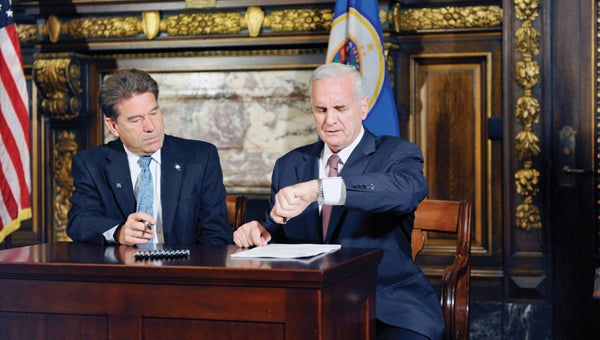Local legislators leery of budget deal
Published 11:27 am Wednesday, July 20, 2011

Minnesota Gov. Mark Dayton checks the time Wednesday in St. Paul as he sits down with Secretary of State Mark Ritchie to sign the budget bill, ending the Minnesota government shutdown. When the state government shut down on July 1, it closed state parks and rest stops, laid off 22,000 state employees, stopped road projects and much more. -- AP Photo/Jim Mone
Poppe: Borrowing against the future a slippery slope
Local legislators say they are relieved the state shutdown has come to a close, but worries about Minnesota’s future still remain.
Democratic Gov. Mark Dayton signed nine budget bills at 9 a.m. Wednesday morning, formally ending the 20-day shutdown — the nation’s longest by a state government in a decade.
“Certainly the shutdown is coming to an end, but it doesn’t mean the resolution or the outcome of the budget is going to be more apparent,” Rep. Jeanne Poppe, DFL-Austin, said. “At a certain point, the day of reckoning is going to come. We will again face a deficit in the next biennium.”
The end of the shutdown came quickly, as legislators spent 12 hours in a special session with Dayton signing off on the bills just six hours after they passed.
Poppe said some legislators were uncomfortable with how quickly things went once session started. Individually, many of the bills stretched to hundreds of pages, meaning many lawmakers were voting based on little knowledge of what was contained within.
“I think there’s definitely a concern that the legislators are making decisions in what is a very serious situation in a span of 12 hours, when typically that would happen from January to May of a given year. That’s unheard of,” she said. “The K-12 education bill was posted and they kept making changes to it until an hour before the vote was taken.”
In the end, Dayton gave up on the tax increases he had been pushing, while Republicans agreed to soften spending cuts with $1.4 billion in new revenue by delaying state aid payments to schools and borrowing against future payments from a legal settlement with tobacco companies.
Poppe said borrowing against the future is a slippery slope, and Minnesota legislators need to discuss Minnesota’s needs and values before another attempt at balancing the budget.
“We borrowed against the future in order to pay the current bills,” she said. “Although we do that when we bond for projects, it’s different to do it when we’re bonding for everyday expenses.
“It’s a real slippery slope to go down.”
Sen. Dan Sparks, DFL-Austin, agreed that steps need to be taken to avoid another shutdown in the future.
“We really need to come together as leaders and find a way to avoid this from happening,” he said. “A government shutdown should not be a negotiation tool or the ultimate decider. Way too many people are affected by it.”
About 22,000 state employees were temporarily laid off for the duration of the shutdown. Dayton Chief of Staff Tina Smith said previously that state employees would get 24-hour notice before returning to work, likely on Thursday. Top Dayton adviser Jim Schowalter told reporters it could take weeks to work through paperwork backlogs and clean up parks and other sites.
Once back on the job, state workers will re-open state parks, restart highway construction projects and turn the state lottery back on. They’ll also get back to issuing drivers licenses and permits for alcohol sales, and get dozens of other government services going again.
While many of the specific budget impacts have yet to be outlined for local officials, Rep. Rich Murray, R-Albert Lea, said there were some positive local decisions that came out of the budget bills.
Because of the shifts in state money to the schools, legislators implemented an extra $50 per pupil into the funding formula. Special education funding will also see a 4.6 percent increase throughout the next two years, he said.
However, Local Government Aid and County Program Aid have been frozen at 2010 levels through at least 2012.
Poppe said the LGA and CPA freeze is a positive thing because there had previously been talks of drastically cutting the programs. However, the freeze could hurt cities and counties that were expecting more aid in 2011 than in 2010.
“Cities are going to have to figure out if they can continue to have the amount of services they have currently, or if they’re going to raise local property taxes to pay things,” Poppe said.
In addition to the nine budget bills, lawmakers approved a pension bill and legislation allocating dedicated sales tax money to outdoors and cultural programs. They approved a $498 million construction bonding projects bill that includes $51 million for a new physics building at the University of Minnesota, $42 million for a new science and engineering laboratory at St. Cloud State University, $50 million for flood control projects around the state, and $56 million for transportation projects with more than half to local bridge replacement and repairs.
Sparks said Austin could benefit from the flood control bonding dollars. Some smaller communities throughout southeastern Minnesota could also take advantage of funding available from the Legacy bill, which appropriates money for clean water, parks and the arts, Sparks said.
Dayton said Tuesday he was relieved to see an end to the shutdown on the horizon.
“Everyone will look at this, including ourselves, and say, ‘Well, we didn’t have this, we don’t have that, we have this we don’t want, we have that we don’t want’ — that’s just the essence of compromise,” Dayton said.
— The Associated Press and reporter Sarah Stultz contributed to this report.




